Birdfinding.info ⇒ Generally common and easy to find in warm offshore waters of the Gulf of Mexico and U.S. Atlantic Coast from May to November. Especially common in Gulf Stream waters from Florida to North Carolina, where it may be present throughout the year (but less numerous from around December to March). Also common year-round along the eastern rim of the West Indies, from the Bahamas to Tobago, where it is usually the predominant tubenose. Brazilian populations are little-known.
Audubon’s Shearwater
Puffinus lherminieri
Breeds on Caribbean islands from the Bahamas to Tobago and Panama, and locally to southeastern Brazil.
Range at sea is generally warm offshore waters of the Caribbean Sea and western Atlantic from Nova Scotia to southeastern Brazil.
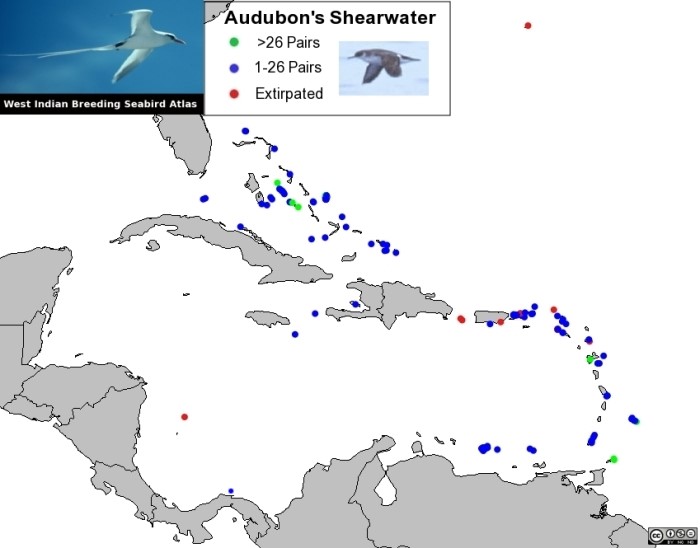
Known nesting grounds of the Audubon’s Shearwater in the Caribbean region. © West Indian Breeding Seabird Atlas 2010
Breeding. Breeds from January to July at approximately 125 sites in the Caribbean, most in the Bahamas and Lesser Antilles, from Grand Bahama south to Tobago, and with a few on islets among the Greater Antilles and in the southern Caribbean off of Nicaragua, Panama, and Venezuela.
Most nesting sites are not well surveyed, so the available information is far from complete, but research to date indicates that the bulk of the population breeds in the central Bahamas, where the largest colonies are on at Elbow Cay, Long Cay, and Allen Cay.
Elsewhere the largest concentrations are suspected to be on offshore islands of Venezuela (the Los Roques and Las Orchillas archipelagos) and on islets adjacent to Tobago. There are also several significant nesting sites scattered across the Virgin Islands and Lesser Antilles.
In the southwestern Caribbean, outpost populations breed on the Tiger Cays off of western Panama and, at least formerly, east of Nicaragua on islets near Isla Providencia.
In Brazil, it is known to breed on Fernando de Noronha and nearshore islets along the coast of Espírito Santo. The breeding season there begins around July, with eggs hatching around September.
Formerly bred on Bermuda, where it was extirpated around the 1980s. Extirpated centuries ago from many West Indian islands due to harvesting by humans and the introduction of mongoose and rats. Islands that have evidence of large former colonies include Abaco, Eleuthera, Mona, Anegada, and Anguilla.
Nonbreeding. Ranges year-round throughout the Caribbean and adjacent Atlantic waters east to the Guianas.
From spring into fall, large numbers occupy the Sargasso Sea and Gulf Stream, where it is common north to Virginia. From July to October, smaller numbers range north and east to Nova Scotia. Also a fairly common nonbreeding visitor to the Gulf of Mexico.
Its distribution pattern in the South Atlantic is poorly understood, but it has been found from Fernando de Noronha south at least as far as Paraná.
Identification
A small shearwater with a proportionately long, broad tail and broad, somewhat rounded wings.
Often holds its tail partially spread, and sometimes fans it out when banking or gliding, which makes its size more noticeable. When held closed, the tail is slightly wedge-shaped.
Flight is low, generally remaining within a few feet of the water. Typical pattern is to alternate between stiff-winged flutters and brief glides.
The upperparts are uniform medium-brown—though, depending on lighting and molt stage, it may appear anywhere on the brown spectrum from blond to blackish. Like many similar species, it often shows small white patches on the sides of the rump.
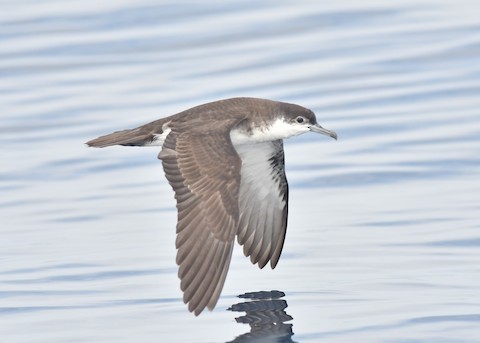
Audubon’s Shearwater. (Offshore from Palm Beach, Florida; May 7, 2019.) © Marcus Kelly
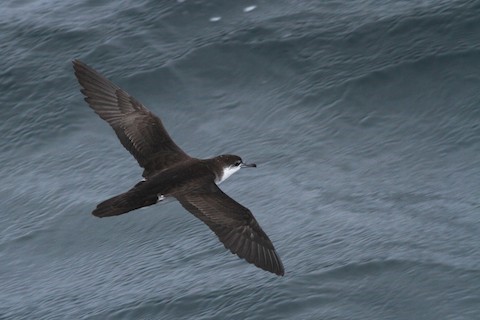
Audubon’s Shearwater—note long, rounded tail. (Offshore from Nantucket, Massachusetts; September 24, 2016.) © Evan Lipton
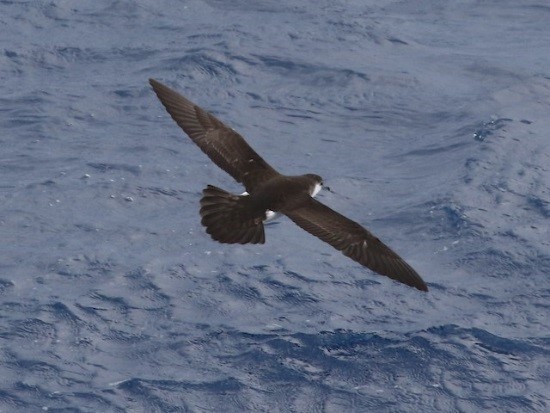
Audubon’s Shearwater, with tail spread, showing its full size. (Offshore from Cape Hatteras, North Carolina; August 25, 2017.) © Steve Calver
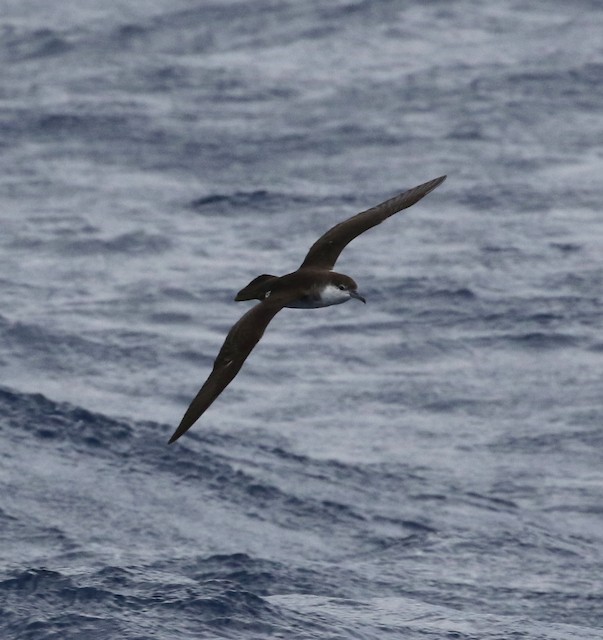
Audubon’s Shearwater. (Offshore from Cape Hatteras, North Carolina; August 25, 2017.) © Tom Benson
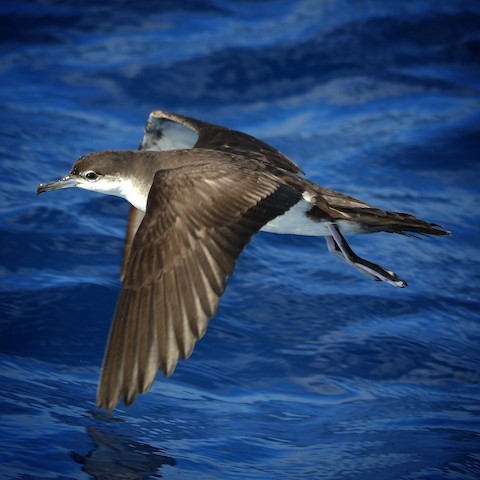
Audubon’s Shearwater. (Dry Tortugas National Park, Florida; April 18, 2018.) © Jeff Kietzmann
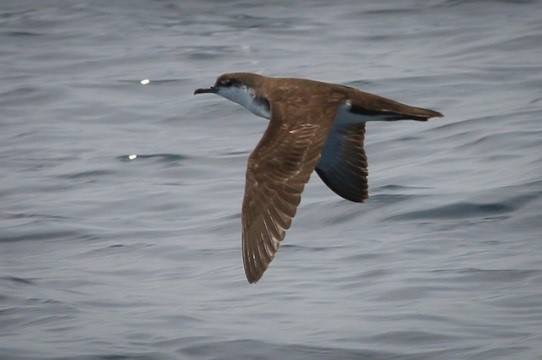
Audubon’s Shearwater, showing medium-brown upperparts. (Offshore from Cape Hatteras, North Carolina; June 1, 2017.) © Skip Russell
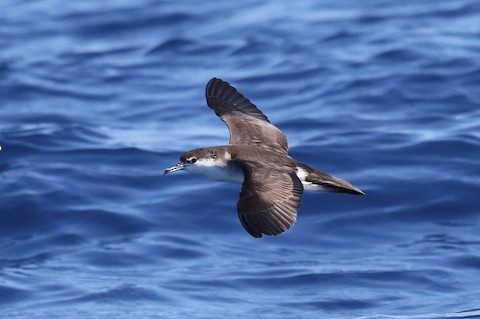
Audubon’s Shearwater. (Offshore from Cape Hatteras, North Carolina; August 13, 2016.) © Knut Hansen
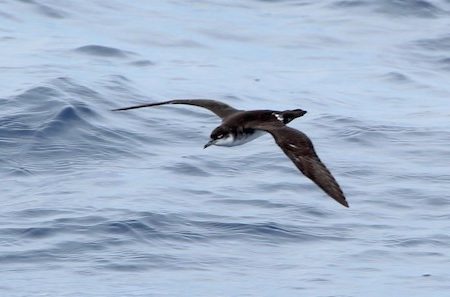
Audubon’s Shearwater, with upperparts appearing blackish. (Offshore from Brevard County, Florida; July 28, 2018.) © Gary Leavens
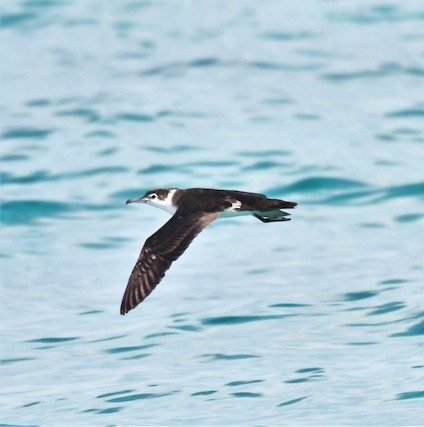
Audubon’s Shearwater, showing atypically white face and white collar. (Goulding Cay Wild Bird Reserve, New Providence, Bahamas; July 7, 2018.) © Christopher Johnson
The underparts are mostly white, except that the undertail coverts are usually dark-brown. The underwings have white linings broadly bordered with brown—often with a distinctly irregular boundary between them.
On the head and neck the transition from brown to white usually appears blurred and uneven. The eye is typically on the dark side of the transition, but often has some white around it.
The bill is proportionately long and thin. It is mostly gray with a slight bluish tint, and usually shows a distinctly darker, blackish tip.
The feet can appear either pinkish or grayish.
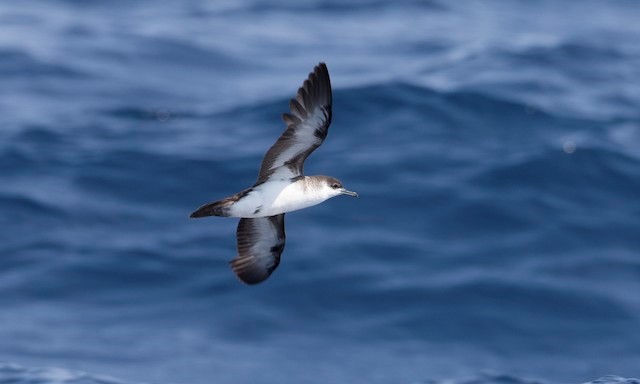
Audubon’s Shearwater, showing white underwing linings with irregular brown borders. (Offshore from Cape Hatteras, North Carolina; June 7, 2018.) © Brian Sullivan
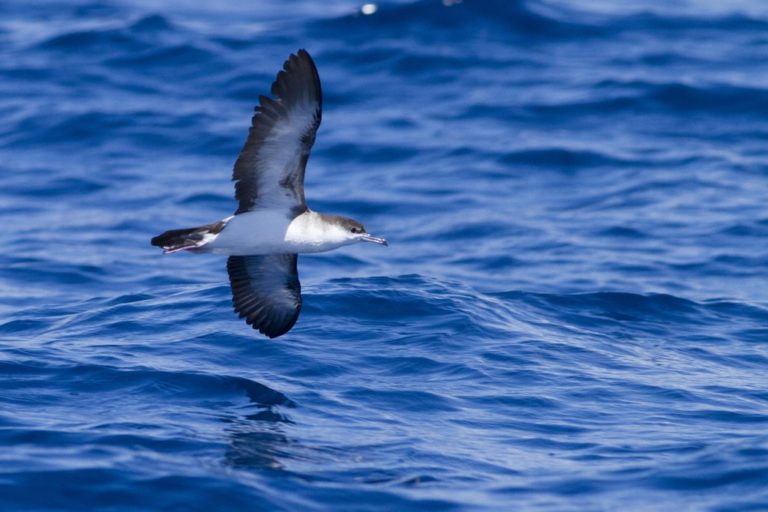
Audubon’s Shearwater. (Offshore from Cape Hatteras, North Carolina; August 13, 2016.) © Lucas Bobay

Audubon’s Shearwater, showing white underwing linings with irregular brown borders. (Offshore from Cape Hatteras, North Carolina; June 4, 2009.) © Michael O’Brien

Audubon’s Shearwater. (Offshore from Cameron County, Texas; August 8, 2015.) © Arman Moreno
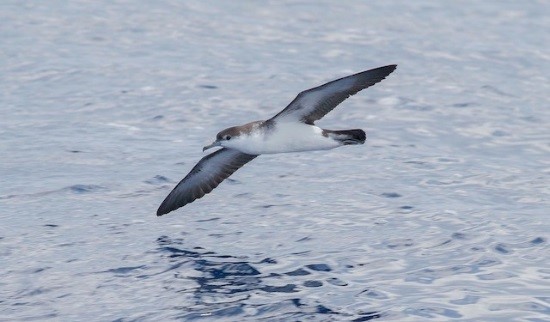
Audubon’s Shearwater. (Offshore from Cape Hatteras, North Carolina; July 26, 2014.) © Nick Pulcinella

Audubon’s Shearwater. (Offshore from Cape Hatteras, North Carolina; July 28, 2017.) © Kate Sutherland
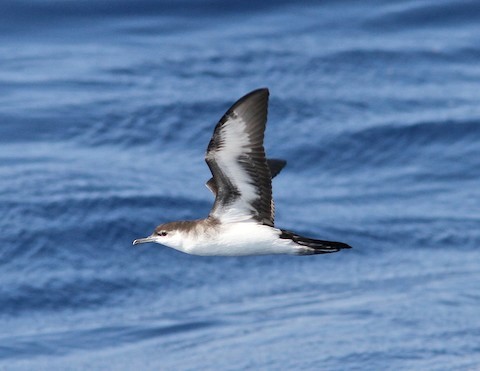
Audubon’s Shearwater, showing white underwing linings with irregular brown borders. (Offshore from Cape Hatteras, North Carolina; August 13, 2011.) © Holly Merker
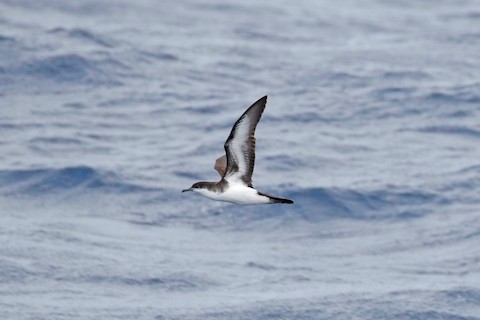
Audubon’s Shearwater, showing white underwing linings with irregular brown borders. (Offshore from Cape Hatteras, North Carolina; May 26, 2019.) © David McQuade

Audubon’s Shearwater, showing wings and tail fully fanned out. (Offshore from Cape Hatteras, North Carolina; August 7, 2015.) © Jay McGowan

Audubon’s Shearwater. (Offshore from Cape Hatteras, North Carolina; July 26, 2014.) © Nick Pulcinella

Audubon’s Shearwater. (Offshore from Brevard County, Florida; July 24, 2016.) © Mike Charest

Audubon’s Shearwater. (Offshore from Plaquemines, Louisiana; September 2, 2017.) © Hal Mitchell
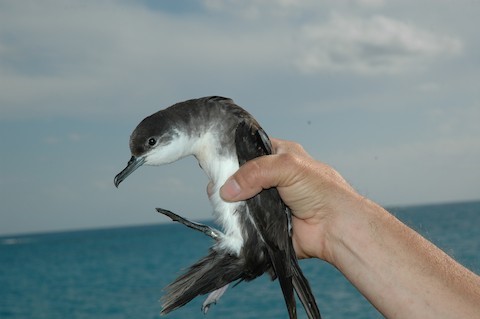
Audubon’s Shearwater. (Castle Harbour Islands, Bermuda; May 6, 2011.) © Andrew Dobson
Cf. Manx Shearwater. Manx and Audubon’s Shearwaters often occur together off the east coast of North America, and can be confused with one another under some circumstances. The most consistent differences are structural and behavioral. Manx is larger, with a proportionately heavier body, much shorter tail, and thinner, more pointed wings. Audubon’s typically flies low, adjusting its flight path to the water surface, whereas Manx has a remarkably fast, irregular flight pattern with frequent arcs and dips.
Plumage differences are more subtle and harder to apply due to variability in both species:
Undertail: Manx always has white undertail coverts, whereas Audubon’s are usually dark, but mostly white on some individuals (although the underside of the tail itself is always dark).
Upperparts: Manx usually has dark, blackish upperparts, whereas Audubon’s usually shows as distinctly brownish, and often appears quite pale.
Neck Mark: Manx consistently shows a narrow white indentation—reminiscent of a gill—just behind its dark cheek. The shape is like an inverted white comma. Some Audubon’s have a similar facial pattern, but rarely with the same inverted comma shape.
Face: Although it varies individually, Audubon’s typically has a paler face than Manx, sometimes showing white around the eye—which Manx seemingly never does.
Cf. Boyd’s Shearwater. Although their current ranges are not known to overlap, Audubon’s and Boyd’s Shearwaters present a potentially challenging identification puzzle—and to complicate matters further they have sometimes been considered conspecific, so some references do not distinguish between them. There is substantial evidence that both species bred colonially on Bermuda. (Olson 2010) Boyd’s is currently known only from the waters around Cape Verde and has not been definitively recorded in the western North Atlantic in modern times, but may occur undetected (it would be difficult to detect).
Boyd’s has approximately the same structure as Audubon’s—small with a proportionately long tail and broad wings—but it is smaller, with shorter, broader wings and a slightly shorter tail (intermediate between Audubon’s and Barolo). Boyd’s typically has more extensive white on the face, with more white above the eye, although the facial patterns of both species vary in these details.
Cf. Barolo Shearwater. Barolo is the smallest shearwater in the North Atlantic. It is known to occur at least occasionally off the coast of North America, where it could be mistaken for Audubon’s. Barolo differs from Audubon’s in several respects: it has a shorter tail, white undertail coverts, very short, fine bill, and extensively white face. Barolo’s wings are also shorter, and on the upperside they usually show a whitish stripe across the secondary coverts.
Notes
Polytypic species consisting of two recognized subspecies. Formerly combined with eleven similar forms—Boyd’s (boydi), Persian (persicus), “Mohéli” (temptator), Seychelles (nicolae), “Aldabra” (colstoni), Baillon’s (bailloni), Bannerman’s (bannermani), Micronesian (dichrous), Melanesian (gunax), Polynesian (polynesiae), and Galápagos (subalaris)—to comprise a single, pantropical species known collectively as Audubon’s Shearwater (P. lherminieri).
References
Alderfer, J., and J.L. Dunn. 2014. National Geographic Complete Birds of North America (Second Edition). National Geographic Society, Washington, D.C.
BirdLife International. 2018. Puffinus lherminieri. The IUCN Red List of Threatened Species 2018: e.T45959182A132669169. https://dx.doi.org/10.2305/IUCN.UK.2018-2.RLTS.T45959182A132669169.en. (Accessed June 23, 2020.)
Carboneras, C., F. Jutglar, and G.M. Kirwan. 2018. Audubon’s Shearwater (Puffinus lherminieri). In Handbook of the Birds of the World Alive (J. del Hoyo, A. Elliott, J. Sargatal, D.A. Christie, and E. de Juana, eds.). Lynx Edicions, Barcelona. https://www.hbw.com/node/52580. (Accessed September 17, 2018.)
eBird. 2020. eBird: An online database of bird distribution and abundance. Cornell Lab of Ornithology, Ithaca, N.Y. http://www.ebird.org. (Accessed June 23, 2020.)
ffrench, R. 2012. A Guide to the Birds of Trinidad & Tobago (Third Edition). Cornell University Press.
Harrison, P. 1983. Seabirds: An Identification Guide. Houghton Mifflin, Boston.
Howell, S.N.G. 2012. Petrels, Albatrosses & Storm-Petrels of North America. Princeton University Press, Princeton, N.J.
Howell, S.N.G., and K. Zufelt. 2019. Oceanic Birds of the World. Princeton University Press.
Kirwan, G.M., A. Levesque, M. Oberle, and C.J. Sharpe. 2019. Birds of the West Indies. Lynx Edicions, Barcelona.
Lee, D.S., and W.A. Mackin. 2010. Audubon’s Shearwater. West Indian Breeding Seabird Atlas, http://www.wicbirds.net/aush.html. (Accessed June 23, 2020.)
Mackin, W.A. 2016. Current and former populations of Audubon’s Shearwater (Puffinus lherminieri) in the Caribbean region. The Condor 118:655-673.
Olson, S.L. 2010. Stasis and turnover in small shearwaters on Bermuda over the last 400,000 years (Aves: Procellariidae: Puffinus lherminieri group). Biological Journal of the Linnean Society 99:699-707.
Raffaele, H., J. Wiley, O. Garrido, A. Keith, and J. Raffaele. 1998. A Guide to the Birds of the West Indies. Princeton University Press, Princeton, N.J.
Ridgely, R.S., and J.A. Gwynne. 1989. A Guide to the Birds of Panama (Second Edition). Princeton University Press.
van Perlo, B. 2009. A Field Guide to the Birds of Brazil. Oxford University Press.
Wells, J.V., and A.C. Wells. 2017. Birds of Aruba, Bonaire, and Curaçao. Cornell University Press.
Wikiaves, Pardela-de-asa-larga, https://www.wikiaves.com.br/wiki/pardela-de-asa-larga.
